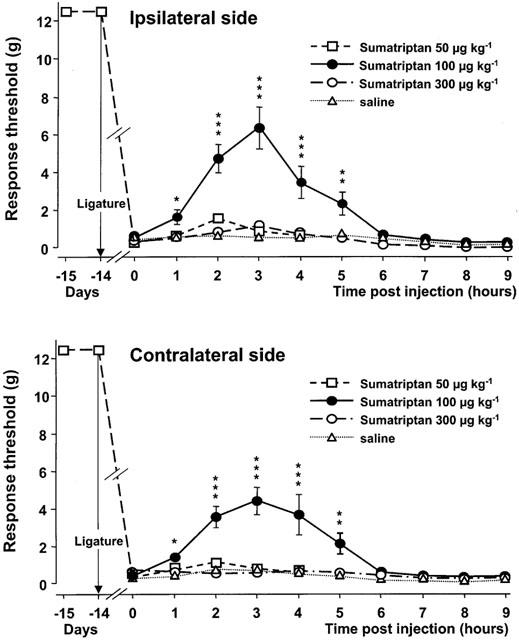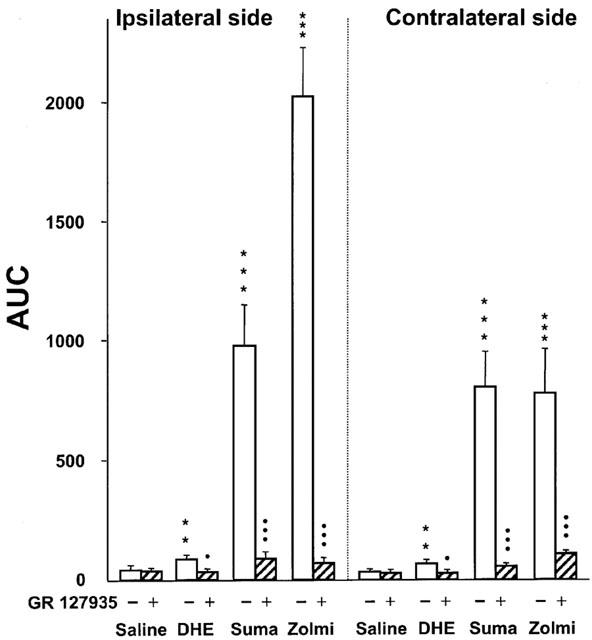
| Size | Price | Stock | Qty |
|---|---|---|---|
| 50mg |
|
||
| 100mg |
|
||
| 250mg |
|
||
| 500mg |
|
||
| 1g |
|
||
| 5g |
|
||
| Other Sizes |
|
Purity: = 99.52%
Sumatriptan Succinate (GR-43175; GR43175; Sumatran; Sumax), an approved triptan sulfa drug and a sulfonamide compound, is a selective 5-HT1 receptor agonist used for the treatment of migraine headaches. It is selective to 5-HT1A, 5-HT1B, and 5-HT1D. Its succinate salt is called sumatriptan succinate.
| Targets |
5-HT1D Receptor ( Ki = 17 nM ); 5-HT1B Receptor ( Ki = 27 nM ); 5-HT1A Receptor ( IC50 = 100 nM )
|
||
|---|---|---|---|
| ln Vitro |
|
||
| ln Vivo |
|
||
| Animal Protocol |
|
||
| References |
| Molecular Formula |
C18H27N3O6S
|
|
|---|---|---|
| Molecular Weight |
413.49
|
|
| Exact Mass |
413.16
|
|
| Elemental Analysis |
C, 52.29; H, 6.58; N, 10.16; O, 23.22; S, 7.75
|
|
| CAS # |
103628-48-4
|
|
| Related CAS # |
Sumatriptan; 103628-46-2; Sumatriptan hydrochloride; 103628-62-2; 143675-45-0 (hemisulfate)
|
|
| Appearance |
White to off-white solid powder
|
|
| SMILES |
CNS(=O)(=O)CC1=CC2=C(C=C1)NC=C2CCN(C)C.C(CC(=O)O)C(=O)O
|
|
| InChi Key |
PORMUFZNYQJOEI-UHFFFAOYSA-N
|
|
| InChi Code |
InChI=1S/C14H21N3O2S.C4H6O4/c1-15-20(18,19)10-11-4-5-14-13(8-11)12(9-16-14)6-7-17(2)3;5-3(6)1-2-4(7)8/h4-5,8-9,15-16H,6-7,10H2,1-3H3;1-2H2,(H,5,6)(H,7,8)
|
|
| Chemical Name |
butanedioic acid;1-[3-[2-(dimethylamino)ethyl]-1H-indol-5-yl]-N-methylmethanesulfonamide
|
|
| Synonyms |
|
|
| HS Tariff Code |
2934.99.9001
|
|
| Storage |
Powder -20°C 3 years 4°C 2 years In solvent -80°C 6 months -20°C 1 month Note: Please store this product in a sealed and protected environment, avoid exposure to moisture. |
|
| Shipping Condition |
Room temperature (This product is stable at ambient temperature for a few days during ordinary shipping and time spent in Customs)
|
| Solubility (In Vitro) |
|
|||
|---|---|---|---|---|
| Solubility (In Vivo) |
Solubility in Formulation 1: ≥ 2.5 mg/mL (6.05 mM) (saturation unknown) in 10% DMSO + 40% PEG300 + 5% Tween80 + 45% Saline (add these co-solvents sequentially from left to right, and one by one), clear solution.
For example, if 1 mL of working solution is to be prepared, you can add 100 μL of 25.0 mg/mL clear DMSO stock solution to 400 μL PEG300 and mix evenly; then add 50 μL Tween-80 to the above solution and mix evenly; then add 450 μL normal saline to adjust the volume to 1 mL. Preparation of saline: Dissolve 0.9 g of sodium chloride in 100 mL ddH₂ O to obtain a clear solution. Solubility in Formulation 2: ≥ 2.5 mg/mL (6.05 mM) (saturation unknown) in 10% DMSO + 90% (20% SBE-β-CD in Saline) (add these co-solvents sequentially from left to right, and one by one), clear solution. For example, if 1 mL of working solution is to be prepared, you can add 100 μL of 25.0 mg/mL clear DMSO stock solution to 900 μL of 20% SBE-β-CD physiological saline solution and mix evenly. Preparation of 20% SBE-β-CD in Saline (4°C,1 week): Dissolve 2 g SBE-β-CD in 10 mL saline to obtain a clear solution. View More
Solubility in Formulation 3: ≥ 2.5 mg/mL (6.05 mM) (saturation unknown) in 10% DMSO + 90% Corn Oil (add these co-solvents sequentially from left to right, and one by one), clear solution. Solubility in Formulation 4: 100 mg/mL (241.84 mM) in PBS (add these co-solvents sequentially from left to right, and one by one), clear solution; with ultrasonication. |
| Preparing Stock Solutions | 1 mg | 5 mg | 10 mg | |
| 1 mM | 2.4184 mL | 12.0922 mL | 24.1844 mL | |
| 5 mM | 0.4837 mL | 2.4184 mL | 4.8369 mL | |
| 10 mM | 0.2418 mL | 1.2092 mL | 2.4184 mL |
*Note: Please select an appropriate solvent for the preparation of stock solution based on your experiment needs. For most products, DMSO can be used for preparing stock solutions (e.g. 5 mM, 10 mM, or 20 mM concentration); some products with high aqueous solubility may be dissolved in water directly. Solubility information is available at the above Solubility Data section. Once the stock solution is prepared, aliquot it to routine usage volumes and store at -20°C or -80°C. Avoid repeated freeze and thaw cycles.
Calculation results
Working concentration: mg/mL;
Method for preparing DMSO stock solution: mg drug pre-dissolved in μL DMSO (stock solution concentration mg/mL). Please contact us first if the concentration exceeds the DMSO solubility of the batch of drug.
Method for preparing in vivo formulation::Take μL DMSO stock solution, next add μL PEG300, mix and clarify, next addμL Tween 80, mix and clarify, next add μL ddH2O,mix and clarify.
(1) Please be sure that the solution is clear before the addition of next solvent. Dissolution methods like vortex, ultrasound or warming and heat may be used to aid dissolving.
(2) Be sure to add the solvent(s) in order.
| NCT Number | Recruitment | interventions | Conditions | Sponsor/Collaborators | Start Date | Phases |
| NCT00356603 | Completed | Drug: Sumatriptan Succinate | Migraine Disorders | GlaxoSmithKline | June 20, 2006 | Phase 3 |
| NCT01269281 | Completed | Drug: Sumatriptan | Healthy | Dr. Reddy's Laboratories Limited |
July 2005 | Phase 1 |
| NCT01507610 | Completed | Drug: Sumatriptan | Migraine | Optinose US Inc. | January 2012 | Phase 1 |
| NCT00847405 | Completed | Drug: Sumatriptan Succinate Drug: Imitrex® |
Healthy | Teva Pharmaceuticals USA | March 2003 | Phase 1 |
| NCT00846885 | Recruiting | Drug: Sumatriptan Succinate Drug: Imitrex® |
Healthy | Teva Pharmaceuticals USA | August 2004 | Phase 1 |
 |
|---|
 |